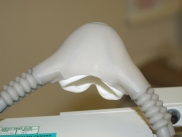Sedation & Happy Gas
Inhalation Sedation (Laughing Gas)
Inhalation sedation, laughing gas, relative analgesia, RA, happy gas, gas, nitrous, nitrous oxide, N2O-O2 has been described as “representing the most nearly ‘ideal’ clinical sedative circumstance. Sedation is a dental solution designed for patients who dread going to the dentist; for patients who fear dental procedures and needles, have difficulty with their gag reflex, have very sensitive teeth or have difficulty becoming numb from injections.
Nitrous oxide (inhalation) sedation or sometimes known as Happy Gas, is the most common sedation. Inhalation sedation is a preferable option as patients recover quickly and may immediately continue their normal activities.
What is it? And what does it do?
Nitrous oxide (N2O) is simply a gas which you can breathe in. It has no colour or smell and doesn’t irritate.
The effects of nitrous oxide: it induces a pleasurable feeling. After 5 minutes or so of breathing in the gas, you should feel a euphoric feeling spread throughout your body. Its really kind of feels like a ‘happy drunk’ feeling. Some people find that there are auditory or visual effects as well. You will feel a bit light headed and often people get ‘the giggles’ (hence the name laughing gas).
How does nitrous oxide work?
Depending on the concentration and length of administration of laughing gas, four levels of sedation can be experienced (after an initial feeling of light-headedness):
- A tingling sensation, especially in the arms and legs, or a feeling of vibration (“parasthesia”), quickly followed by
- Warm sensations, and
- A feeling of well-being, euphoria and/or floating. During heavier sedation, hearing may dissolve into a constant, electronic-like throbbing.
- At a deeper level of sedation again, sleepiness, difficulty to keep one’s eyes open or speak (“dream”) can occur. Should nausea set in, it means you’re definitely over sedated!
If you experience any unpleasant symptoms, let your dentist know so that they can adjust the percentage of N2O. Alternatively, just take the mask off.
How is nitrous oxide administered?

The equipment used for delivering “happy gas” is quite simple. It consists of a supply of compressed gases and an apparatus which delivers the gases to the client. By turning some knobs and flipping on/off switches, the administrator can produce the desired mix of N2O-O2 in the desired quantities. Flow meters and pressure gaugesallow the administrator to keep an eye on the flow of gases.
The desired N2O-O2 mix is fed through a tube to which a nasal hood or cannula is attached. This hood is put over your nose. All you have to do now is breathe normally through your nose.
In modern machines there is a sort of double mask (see photo) where the outside mask is connected to a vacuum machine to suck away the waste gas
What are the advantages of nitrous oxide?
- Nitrous oxide works very rapidly – it reaches the brain within 20 seconds, and relaxation and pain-killing properties develop after 2 or 3 minutes.
- The depth of sedation can be altered from moment to moment, allowing the person who administers the gas to increase or decrease the depth of sedation, the effects are almost instant.
- Gas can be given for the exact time span it’s needed for. It can also be switched off when not needed and then switched on again (though to avoid a roller-coaster effect).
- There’s no “hangover” effect
- With nitrous oxide, it’s easy to give incremental doses until the desired action is obtained (this is called “titration”). So the administrator has virtually absolute control over the action of the drug, preventing the possibility of accidental overdoses.
- For certain procedures – those involving gums rather than teeth (e. g. deep cleaning) – it may be possible to use nitrous instead of local anaesthesia. N2O acts as a painkiller on soft tissues such as gums. However, its pain-relieving effects vary a lot from person to person and can’t be relied upon.
- No injection is required. In cases of very severe needle phobia
- Inhalation sedation is very safe.
- Inhalation sedation has been found to be very effective in eliminating or at minimizing severe gagging.
Are there any disadvantages?
- Some people are not comfortable with the effects of laughing gas (either because they’re afraid they might lose control or because it makes them feel nauseous – this is quite rare, though, and usually due to over sedation). If you’re prone to nausea, it’s a good idea to have a meal (not a huge one) about 4 hours before your appointment. If that’s not possible (e. g. an early morning appointment), make sure your stomach isn’t completely empty – but don’t stuff yourself straight beforehand either.
- Apart from that, most of the disadvantages of inhalation sedation don’t affect you.
Are there any contraindications?
There aren’t any major contraindications to relative analgesia, except for M.S., emphysema and some exotic chest problems. It hasn’t been proven to be safe during the first trimester of pregnancy, so you can’t use it then.
Because you have to breathe it in through your nose, it’s not suitable for people who have a cold or some other condition which prevents them from breathing through their nose.








